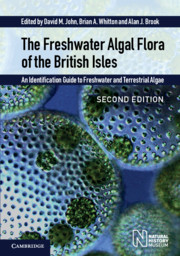 The Freshwater Algal Flora of the British Isles
The Freshwater Algal Flora of the British Isles Published online by Cambridge University Press: 12 January 2024
Introduction
The brown algae comprise a division, the Phaeophyta, characterized by thalli with a brown or yellow-brown colour, which results from the carotenoid pigment fucoxanthin. Major photosynthetic pigments are chlorophylls a, c1 and c2, plus varying amounts of β-carotene, violaxanthin and diatoxanthin (Goodwin, 1974; Hoek et al., 1995). Their colour is also influenced by phaeophycean tannins, which occur in physodes (Svedelius, 1930; Chadefaud, 1950), and may render specimens darker brown or black. The primary photosynthetic storage product is laminarin, a water-soluble β1–3 glucan. Cell walls are composed of cellulose, alginic acid and sulphated polysaccharides; relative proportions vary among species and environmental conditions. Traditionally, members of the division have been based on morphology, pattern of growth and type of reproductive structures (De Reviers and Rousseau, 1999; Hoek et al., 1995). Ultrastructural features of cells and reproductive structures for the group have been described by Hoek et al. (1995). A comprehensive study of the division based on rbcL and LSU rDNA data across all known orders suggest that some morphological and developmental features do not reflect their true evolutionary relationships (Phillips et al., 2008).
Currently the division is estimated to contain roughly 270 genera and perhaps 2000 species worldwide (Hoek et al., 1995; De Reviers and Rousseau, 1999). Nearly all species classified within the Phaeophyta occur in marine habitats, and range in size and complexity from microscopic, uniseriate filaments to macroscopic parenchymatous seaweeds. There are also many species common in estuarine and salt marsh environments (Waern, 1952; Dop, 1979). Freshwater species are few in number and more modest in size, occurring mainly as microscopic filaments or macroscopic tufts or crusts, from several μm to a few cm in size (Wehr, 2003). Some freshwater representatives are globally cosmopolitan and have been known for more than 100 years. In earlier accounts, most freshwater species of brown algae have been classified in the Ectocarpales or Sphacelariales (Starmach, 1977). Recent molecular data suggest that the genus Heribaudiella does not fall within either order, but perhaps belongs in an order of its own (McCauley and Wehr, 2007).
Distribution and Ecology
Despite some taxa having been described more than 150 years ago, such as Pleurocladia (Braun, 1855), the distribution and ecology of freshwater phaeophytes are incompletely understood and very likely underreported in the phycological literature.
To save this book to your Kindle, first ensure [email protected] is added to your Approved Personal Document E-mail List under your Personal Document Settings on the Manage Your Content and Devices page of your Amazon account. Then enter the ‘name’ part of your Kindle email address below. Find out more about saving to your Kindle.
Note you can select to save to either the @free.kindle.com or @kindle.com variations. ‘@free.kindle.com’ emails are free but can only be saved to your device when it is connected to wi-fi. ‘@kindle.com’ emails can be delivered even when you are not connected to wi-fi, but note that service fees apply.
Find out more about the Kindle Personal Document Service.
To save content items to your account, please confirm that you agree to abide by our usage policies. If this is the first time you use this feature, you will be asked to authorise Cambridge Core to connect with your account. Find out more about saving content to Dropbox.
To save content items to your account, please confirm that you agree to abide by our usage policies. If this is the first time you use this feature, you will be asked to authorise Cambridge Core to connect with your account. Find out more about saving content to Google Drive.